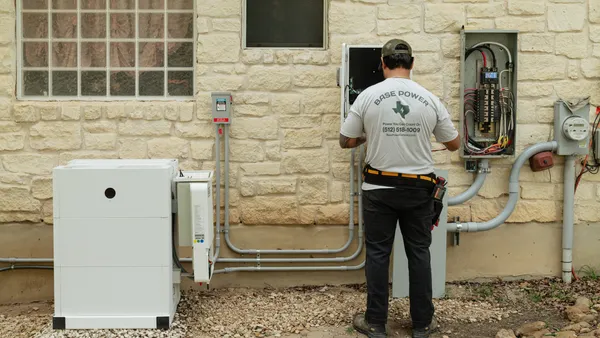Dive Brief:
-
Pacific Gas & Electric (PG&E) is tapping into two lithium-ion battery storage projects — totaling 43.25 MW/173 MWh — to address reliability needs in the Oakland area, the utility said in an application filed with the California Public Utilities Commission (CPUC) Wednesday.
-
The projects are part of the Oakland Clean Energy Initiative, a "first-of-its-kind" utility-community choice aggregator (CCA) collaboration aimed at promoting clean energy alternatives in the region, and replacing a 165 MW jet fuel power plant that's been in operation for 40 years.
-
The projects are part of the larger shift away from traditional generation and transmission to more distributed energy resources, PG&E spokesperson Paul Doherty told Utility Dive. If approved by the CPUC, PG&E expects that they will be operational by the first quarter of 2022.
Dive Insight:
The projects are an environmentally conscious reliability solution for the Oakland community, which has been identified by the California Environmental Protection Agency as having one of the worst pollution profiles in the Bay area, Doherty said.
The region is currently served by the Oakland Power Plant, operated by Vistra Energy subsidiary Dynegy Oakland, which holds a reliability must-run contract from the California Independent System Operator. The system operator has identified the plant's retirement as a risk to transmission reliability in the region, PG&E said in a previous press release.
"There's been widespread support and this solution really does a number of things — it's going to improve air quality, reduce greenhouse gas emissions, it supports local jobs and provides continued service reliability. And then, it enables the retirement of an aging fossil generation power plant," he said.
The Oakland Clean Energy Initiative, launched by PG&E and local CCA East Bay Community Energy (EBCE), addresses this problem with "a novel approach to grid reliability," Doherty said.
"[It] uses targeted distributed energy resource deployment — so targeted energy storage — and then investment in the surrounding grid infrastructure," he said, adding that the whole initiative is intended to replace the Oakland Power Plant at some point in the near future.
PG&E and EBCE issued a request for offers for the project in early 2018, which resulted in PG&E selecting two storage projects — a 36.25 MW battery system developed by Dynegy, which will be located on the site of the Oakland Power Plant, and a 7 MW project operated by Tierra Robles Energy Storage. Both systems have a four-hour duration.
The initiative is a first-of-its-kind utility-CCA collaboration, Doherty said.
Both EBCE and PG&E will be tapping into the same battery projects, but using them for different reasons. While EBCE is using the resources to participate in the CAISO markets, PG&E has signed local area reliability services agreements with the projects, which requires them to be constructed at a location where they can be electronically connected to specific distribution substations.
Howard Chang, chief operating officer at EBCE, agreed that the collaboration is "pretty unique." Although PG&E and EBCE negotiated their contracts separately, they are each contingent on the other moving forward, he said.
"The ball is really in CPUC's court to approve those contracts with PG&E," he said.
Vistra expects that its battery project will be operational by January 2022, the company announced in a press release, adding that it plans to eventually retire the Oakland Power Plant and build more storage projects on its site.
PG&E in 2018 also applied for approval of four energy storage projects, with a collective capacity of 567 MW, to meet reliability needs. This includes a 182.5 MW Tesla battery project at its Moss Landing substation, which is expected to come online in the first quarter of 2021.














